Yeah, it is a bug. Here is patched version: my.plot.biwavelet()
This version accepts argument cex.axis (defaults to 1), and you can change it when needed. I will briefly explain to you what the problem is, in the "explanation" section in the end.
my.plot.biwavelet <- function (x, ncol = 64, fill.cols = NULL, xlab = "Time", ylab = "Period",
tol = 1, plot.cb = FALSE, plot.phase = FALSE, type = "power.corr.norm",
plot.coi = TRUE, lwd.coi = 1, col.coi = "white", lty.coi = 1,
alpha.coi = 0.5, plot.sig = TRUE, lwd.sig = 4, col.sig = "black",
lty.sig = 1, bw = FALSE, legend.loc = NULL, legend.horiz = FALSE,
arrow.len = min(par()$pin[2]/30, par()$pin[1]/40), arrow.lwd = arrow.len *
0.3, arrow.cutoff = 0.9, arrow.col = "black", xlim = NULL,
ylim = NULL, zlim = NULL, xaxt = "s", yaxt = "s", form = "%Y", cex.axis = 1,
...) {
if (is.null(fill.cols)) {
if (bw) {
fill.cols <- c("black", "white")
}
else {
fill.cols <- c("#00007F", "blue", "#007FFF",
"cyan", "#7FFF7F", "yellow", "#FF7F00", "red",
"#7F0000")
}
}
col.pal <- colorRampPalette(fill.cols)
fill.colors <- col.pal(ncol)
types <- c("power.corr.norm", "power.corr", "power.norm",
"power", "wavelet", "phase")
type <- match.arg(tolower(type), types)
if (type == "power.corr" | type == "power.corr.norm") {
if (x$type == "wtc" | x$type == "xwt") {
x$power <- x$power.corr
x$wave <- x$wave.corr
}
else {
x$power <- x$power.corr
}
}
if (type == "power.norm" | type == "power.corr.norm") {
if (x$type == "xwt") {
zvals <- log2(x$power)/(x$d1.sigma * x$d2.sigma)
if (is.null(zlim)) {
zlim <- range(c(-1, 1) * max(zvals))
}
zvals[zvals < zlim[1]] <- zlim[1]
locs <- pretty(range(zlim), n = 5)
leg.lab <- 2^locs
}
else if (x$type == "wtc" | x$type == "pwtc") {
zvals <- x$rsq
zvals[!is.finite(zvals)] <- NA
if (is.null(zlim)) {
zlim <- range(zvals, na.rm = TRUE)
}
zvals[zvals < zlim[1]] <- zlim[1]
locs <- pretty(range(zlim), n = 5)
leg.lab <- locs
}
else {
zvals <- log2(abs(x$power/x$sigma2))
if (is.null(zlim)) {
zlim <- range(c(-1, 1) * max(zvals))
}
zvals[zvals < zlim[1]] <- zlim[1]
locs <- pretty(range(zlim), n = 5)
leg.lab <- 2^locs
}
}
else if (type == "power" | type == "power.corr") {
zvals <- log2(x$power)
if (is.null(zlim)) {
zlim <- range(c(-1, 1) * max(zvals))
}
zvals[zvals < zlim[1]] <- zlim[1]
locs <- pretty(range(zlim), n = 5)
leg.lab <- 2^locs
}
else if (type == "wavelet") {
zvals <- (Re(x$wave))
if (is.null(zlim)) {
zlim <- range(zvals)
}
locs <- pretty(range(zlim), n = 5)
leg.lab <- locs
}
else if (type == "phase") {
zvals <- x$phase
if (is.null(zlim)) {
zlim <- c(-pi, pi)
}
locs <- pretty(range(zlim), n = 5)
leg.lab <- locs
}
if (is.null(xlim)) {
xlim <- range(x$t)
}
yvals <- log2(x$period)
if (is.null(ylim)) {
ylim <- range(yvals)
}
else {
ylim <- log2(ylim)
}
image(x$t, yvals, t(zvals), zlim = zlim, xlim = xlim,
ylim = rev(ylim), xlab = xlab, ylab = ylab, yaxt = "n",
xaxt = "n", col = fill.colors, ...)
box()
if (class(x$xaxis)[1] == "Date" | class(x$xaxis)[1] ==
"POSIXct") {
if (xaxt != "n") {
xlocs <- pretty(x$t) + 1
axis(side = 1, at = xlocs, labels = format(x$xaxis[xlocs],
form))
}
}
else {
if (xaxt != "n") {
xlocs <- axTicks(1)
axis(side = 1, at = xlocs, cex.axis = cex.axis)
}
}
if (yaxt != "n") {
axis.locs <- axTicks(2)
yticklab <- format(2^axis.locs, dig = 1)
axis(2, at = axis.locs, labels = yticklab, cex.axis = cex.axis)
}
if (plot.coi) {
polygon(x = c(x$t, rev(x$t)), lty = lty.coi, lwd = lwd.coi,
y = c(log2(x$coi), rep(max(log2(x$coi), na.rm = TRUE),
length(x$coi))), col = adjustcolor(col.coi,
alpha.f = alpha.coi), border = col.coi)
}
if (plot.sig & length(x$signif) > 1) {
if (x$type %in% c("wt", "xwt")) {
contour(x$t, yvals, t(x$signif), level = tol,
col = col.sig, lwd = lwd.sig, add = TRUE, drawlabels = FALSE)
}
else {
tmp <- x$rsq/x$signif
contour(x$t, yvals, t(tmp), level = tol, col = col.sig,
lwd = lwd.sig, add = TRUE, drawlabels = FALSE)
}
}
if (plot.phase) {
a <- x$phase
locs.phases <- which(zvals < quantile(zvals, arrow.cutoff))
a[locs.phases] <- NA
phase.plot(x$t, log2(x$period), a, arrow.len = arrow.len,
arrow.lwd = arrow.lwd, arrow.col = arrow.col)
}
box()
if (plot.cb) {
fields::image.plot(x$t, yvals, t(zvals), zlim = zlim, ylim = rev(range(yvals)),
xlab = xlab, ylab = ylab, col = fill.colors,
smallplot = legend.loc, horizontal = legend.horiz,
legend.only = TRUE, axis.args = list(at = locs,
labels = format(leg.lab, dig = 2)), xpd = NA)
}
}
Test
library(biwavelet)
t1 <- cbind(1:100, rnorm(100))
t2 <- cbind(1:100, rnorm(100))
# Continuous wavelet transform
wt.t1 <- wt(t1)
par(oma = c(0, 0.5, 0, 0), mar = c(4, 2, 2, 4))
my.plot.biwavelet(wt.t1,plot.cb = T,plot.phase = T,type = 'power.norm',
xlab = 'Time(year)',ylab = 'Period(year)',mgp=c(2,1,0),
main='Winter station 1',cex.main=0.8,cex.lab=0.8,cex.axis=0.8)
As expected, it is working.

Explanation
In plot.biwavelet(), why passing cex.axis via ... does not work?
plot.biwavelet() generates the your final plot mainly in 3 stages:
image(..., xaxt = "n", yaxt = "n") for generating basic plot;axis(1, at = atTicks(1)); axis(2, at = atTicks(2)) for adding axis;fields::image.plot() for displaying colour legend strip.
Now, although this function takes ..., they are only fed to the first image() call, while the following axis(), (including polygon(), contour(), phase.plot()) and image.plot() take none from .... When later calling axis(), no flexible specification with respect to axis control are supported.
I guess during package development time, problem described as in: Giving arguments from “…” argument to right function in R had been encountered. Maybe the author did not realize this potential issue, leaving a bug here. My answer to that post, as well as Roland's comments, points toward a robust fix.
I am not the package author so can not decide how he will fix this. My fix is brutal, but works for you temporary need: just add the cex.axis argument to axis() call. I have reached Tarik (package author) with an email, and I believe he will give you a much better explanation and solution.
